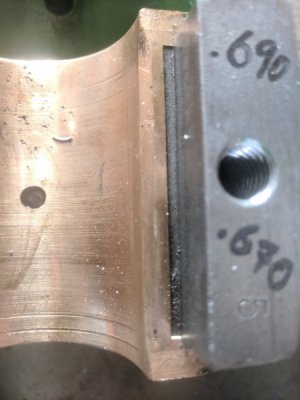- Joined
- Aug 7, 2018
- Messages
- 668
Thanks Izzy, That's brilliant.
Remeasure the tops of the pillars please ! I want to make sure that I'm right.
I'll assume that the bearings themselves are parallel to the line of the spindle.
Earlier you said that the tail bearing would bind up the spindle when you took the shims out. So lets correct that end first.
You can do this two ways. You can use a feeler gauge to determine how much out of parallel the cap and top of the pillar are or you can use plastigauge to do the same thing. Either way you need to correct the tail pillar and cap surfaces, so that you can make up new shims.
Now I know that we only took a 10 thou swipe off the top of the pillars, and that they are not flat all the way across, but if the bulk of the top of the pillar is flat I wouldn't remove any more material.
The way to get the caps flat is to put them into the mill vise and use the bearing shell edges to get the cap level in both directions. The fact that the caps are rectangular is nice insomuch as you have flat surfaces to grip in the mill vice. Do not take any material off the bronze bearing shell or the supporting edge, That shell edge is the only reference surface that you have.
Note that all this is without putting the spindle back in the headstock. Measuring with the spindle in place comes later.
The aim is to have the bearing cap supported on the edges of the bronze shell and the gap on top of the pillar supported with a shim in between. Ideally without any rocking of the cap. If you need to use the hold down bolts only make them finger tight.
Next we will sort the front bearing out.
I'll be around later on.
Remeasure the tops of the pillars please ! I want to make sure that I'm right.
I'll assume that the bearings themselves are parallel to the line of the spindle.
Earlier you said that the tail bearing would bind up the spindle when you took the shims out. So lets correct that end first.
You can do this two ways. You can use a feeler gauge to determine how much out of parallel the cap and top of the pillar are or you can use plastigauge to do the same thing. Either way you need to correct the tail pillar and cap surfaces, so that you can make up new shims.
Now I know that we only took a 10 thou swipe off the top of the pillars, and that they are not flat all the way across, but if the bulk of the top of the pillar is flat I wouldn't remove any more material.
The way to get the caps flat is to put them into the mill vise and use the bearing shell edges to get the cap level in both directions. The fact that the caps are rectangular is nice insomuch as you have flat surfaces to grip in the mill vice. Do not take any material off the bronze bearing shell or the supporting edge, That shell edge is the only reference surface that you have.
Note that all this is without putting the spindle back in the headstock. Measuring with the spindle in place comes later.
The aim is to have the bearing cap supported on the edges of the bronze shell and the gap on top of the pillar supported with a shim in between. Ideally without any rocking of the cap. If you need to use the hold down bolts only make them finger tight.
Next we will sort the front bearing out.
I'll be around later on.


